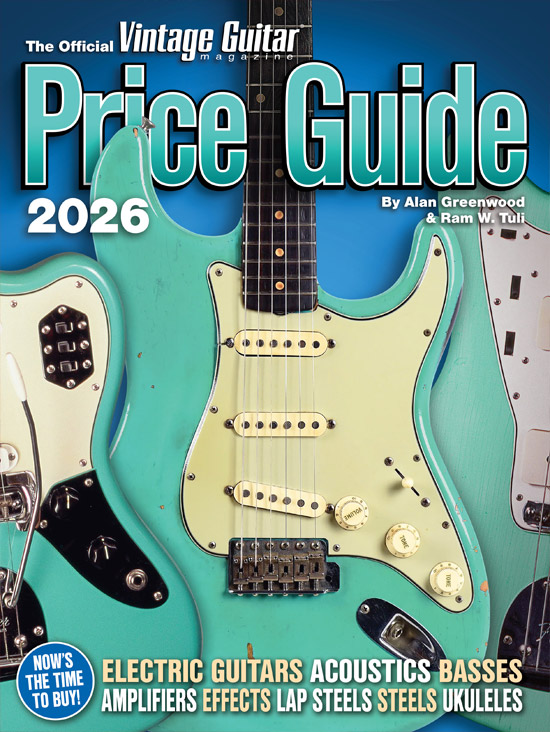
In the September, issue I told the story of the ’58 ES-335 I sold to my friend, Al, for $225 in 1966. Al passed away earlier this year and left the guitar to me. He’d modified its electronics, so I’m restoring them, and I’ll complete the job with my repair buddy, Gene Imbody. A master of guitar electronics, Gene did amazing work including re-winding a dead PAF, restoring the other (which was half-dead), made a vintage-style wiring harness, and aged the hardware and pickup covers. While he was busy, I took care of a variety of small issues.

1) There was a cigarette burn on the peghead, under the low E-string. I scraped the burned lacquer down to clean wood, then…

2) … touched it up with black lacquer, then aged it some to blend with the surrounding finish.

3) Al had removed the pickup covers, as did many players in the early ’70s, supposedly to get a brighter sound. Gene carefully peeled the protective tape from each pickup’s coils and was surprised to find a layer of non-original copper shielding under it; after some research, he figured out that Al had installed the Alembic Hot Rod Kit designed by Rick Turner in the ’70s, which boosted output by swapping the original sand-cast Alnico magnets for larger, more-powerful ceramic. Then, the coils were re-wrapped. I don’t know, but it’s possible the covers couldn’t be reinstalled because of the thickness of the ceramic magnets.
At this point, we also decided the extra switch Al installed was for an in-/out-of-phase switch, not a coil-tap, as we’d thought.

4) A dismantled pickup shows the thicker ceramic magnets and corresponding wood spacers. Over the years, Gene has repaired many pickups and collected parts along the way; he happened to have two ’50 Gibson magnets he donated to the cause, and we got rid of the ceramic.

5) The bridge PAF had one good coil and one dead coil; Gene carefully unwound the wire from the dead coil onto an empty spool, which took many hours – he carried the two spools around as he worked, including on the elevator to his job in the workshop at StewMac.

6) Once the original wire was wound onto the spool – 4,700 winds – Gene had to wind it back on the original coil. To do so, he brazed a handle onto the outer end of the shaft of an electric winder, so he could control the winds by hand – another tedious job. Once the coils were re-joined, the pickup had an output of 3.6k-ohms, which is on the low side of a vintage PAF, but not unheard of. He rewound the second pickup using 42-gauge enamel-coated copper wire, the same as originally used by Gibson. So, we had one rewound original PAF, and one almost entirely original PAF.
With both pickups repaired, Gene moved on to aging the covers and bridge hardware.

7) He starts the aging process by placing a cup with cotton balls soaked in muriatic acid in a plastic container, which traps the fumes. Then, he sets a small board with the parts mounted to it in the container, puts the lid on, and leaves it in the sun for several hours. Gene calls this “fuming.”

8) Before placing the humbucker covers in the container, he spritzed them with soapy water, which randomly tarnishes the metal and creates a vintage look. After fuming, the covers get more treatment.

9) Using a fixture with six strings connected to a tailpiece and six posts, he slides a cover under the strings; with a gloved hand, he holds the board out at arm’s length and spritzes it with a mixture of four parts water and one part ferric chloride, which etches the metal. Then, he quickly washes it in clean water and puts it in the container to get fumed a bit more. He developed this process after much experimentation. The result is great.

10) He aged the pots by taking them apart and etching their outsides with ferric chloride and coloring the PC boards dark brown, like the old ones’ red mahogany Colortone stain. He lubed the pots far more than the factory did, giving them a much smoother travel.

11) Next, he wired a new harness using shielded co-ax from a large spool I got from Gibson in the late ’60s, when my shop was a warranty center. Using an old AC power cord, he made very Gibson-looking black tubing to cover the grounds, he stripped the cover from the wire, hollowed it, and softened it with a heat gun. As if that wasn’t enough for originality, a generous friend sent me a set of original Bumblebee caps! After this, Gene returned the guitar to me.

12) I installed a proper long pickguard, made by C-Rocker Guitars, that I like a lot. The white layers were too bright for such an old guitar, so I aged the plastic with ColorTone Straw stain mixed in acetone and applied with a swab.

13) The job was finished after I made a nut from 6/6 Nylon, the same material Gibson used in the day.
Dan Erlewine has been repairing guitars for more than 50 years. The author of three books, dozens of magazine articles, he has also produced instructional videotapes and DVDs on guitar repair. From 1986 through his retirement in late 2019, Erlewine was part of the R&D team, and company liaison for Stewart-MacDonald’s Guitar Shop Supply. Today, he operates a repair shop in Athens, Ohio, as well as building replicas of the guitars he made for Albert King and Jerry Garcia in 1972. This column has appeared in VG since March, 2004. You can contact him at danerlewine@gmail.com
This article originally appeared in VG’s November 2023 issue. All copyrights are by the author and Vintage Guitar magazine. Unauthorized replication or use is strictly prohibited.



